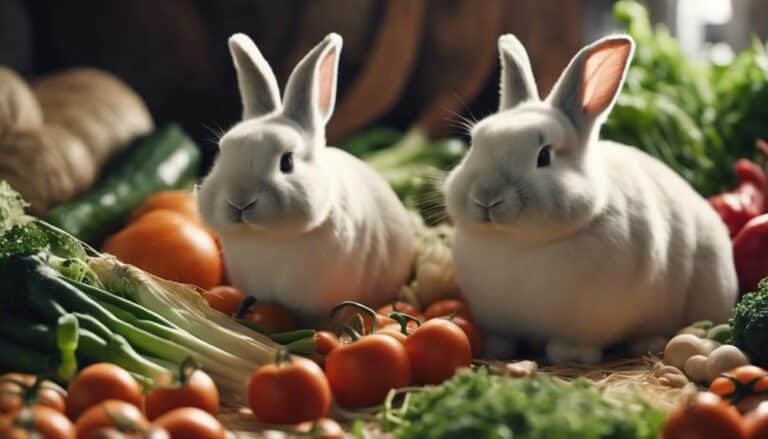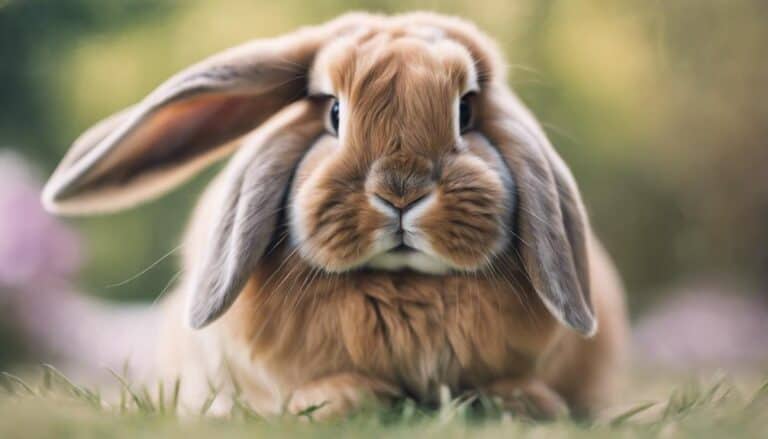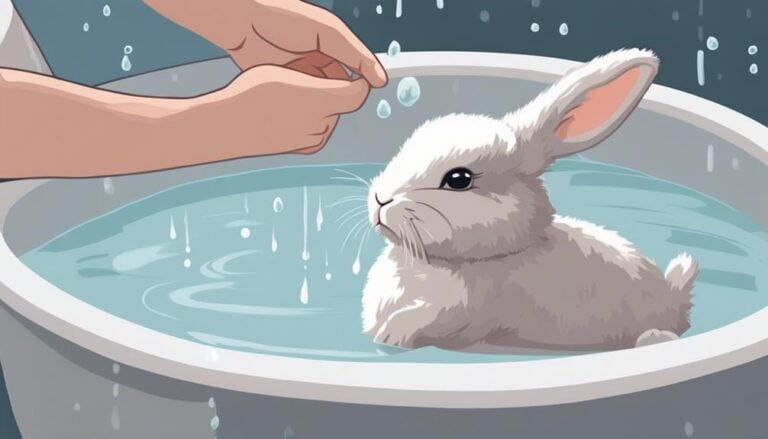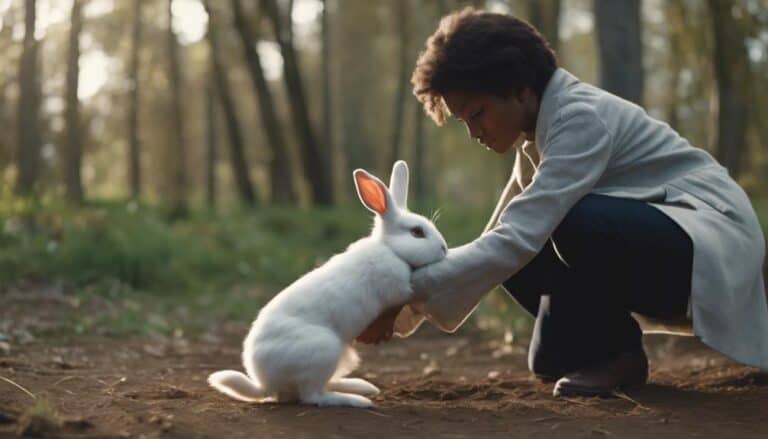Did you know that on average, bunnies molt about every three months?
The molting process in rabbits is a fascinating aspect of their grooming routine.
Understanding how and why bunnies molt can provide valuable insights into their overall health and well-being.
Stay tuned to discover the intricacies of bunny molting and how you can assist your furry friend during this natural shedding phase.
Contents
- 1 Key Takeaways
- 2 Understanding Rabbit Molting
- 3 Molting Process in Bunnies
- 4 Reasons Behind Bunny Molting
- 5 Impact of Molting on Rabbits
- 6 Managing Rabbit Shedding
- 7 Tips for Helping Molting Bunnies
- 8 Recognizing Molting Patterns in Rabbits
- 9 Dealing With Rabbit Hair Loss
- 10 Rabbit Molting Care Essentials
- 11 Do Bunnies Stop Molting When They Are Breastfeeding?
- 12 Frequently Asked Questions
- 13 Conclusion
Key Takeaways
- Molting is crucial for rabbits to regulate body temperature and maintain healthy fur.
- Factors like stress, diet, and genetics influence the molting process.
- Seasonal shedding patterns help bunnies adjust to changing temperatures.
- Proper grooming, balanced diet, and veterinary care are essential during molting.
Understanding Rabbit Molting
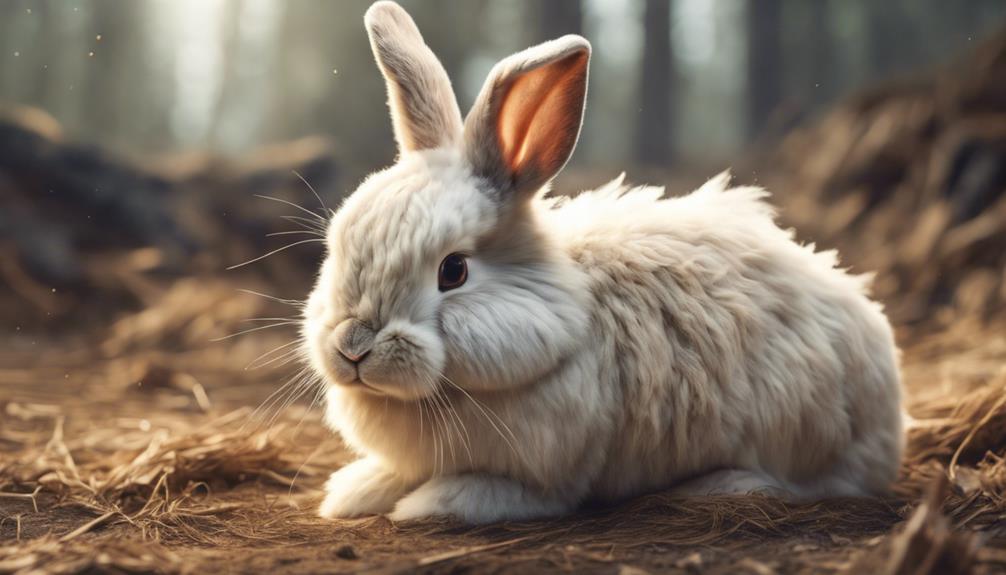
Understanding rabbit molting is essential for rabbit owners to guarantee their pets' well-being and health. Molting, the natural process of shedding fur, is important for rabbits as it helps them regulate their body temperature. While young rabbits may molt twice a year, adult rabbits typically molt mainly in spring and fall.
During molting, rabbits may exhibit changes in the color and patterns of their fur, signaling the shedding of their coat. This shedding process usually initiates at the head and progresses down the body towards the hindquarters. Monitoring your rabbit for signs of molting, such as increased shedding and alterations in fur texture, is crucial for ensuring their health and comfort.
Molting Process in Bunnies
Molting process in bunnies involves shedding old fur to make way for a new coat to grow. During this change, your rabbit's body goes through a natural process that's essential for its well-being.
Here are some key points to think about:
- Shedding Fur: Rabbits molt to get rid of old fur, making space for a fresh coat to grow. This shedding helps them maintain healthy fur and skin.
- Growing a New Coat: As the old fur falls out, a new coat begins to emerge. This pivotal coat is important for your rabbit's comfort and protection.
- Regulating Body Temperature: Molting plays a crucial role in helping rabbits regulate their body temperature. The new coat provides insulation, keeping them warm in winter and cool in summer.
To support your bunny during this process, consider gently brushing your rabbit to help remove loose fur and prevent matting. Understanding the molting process can aid you in caring for your furry friend effectively.
Reasons Behind Bunny Molting
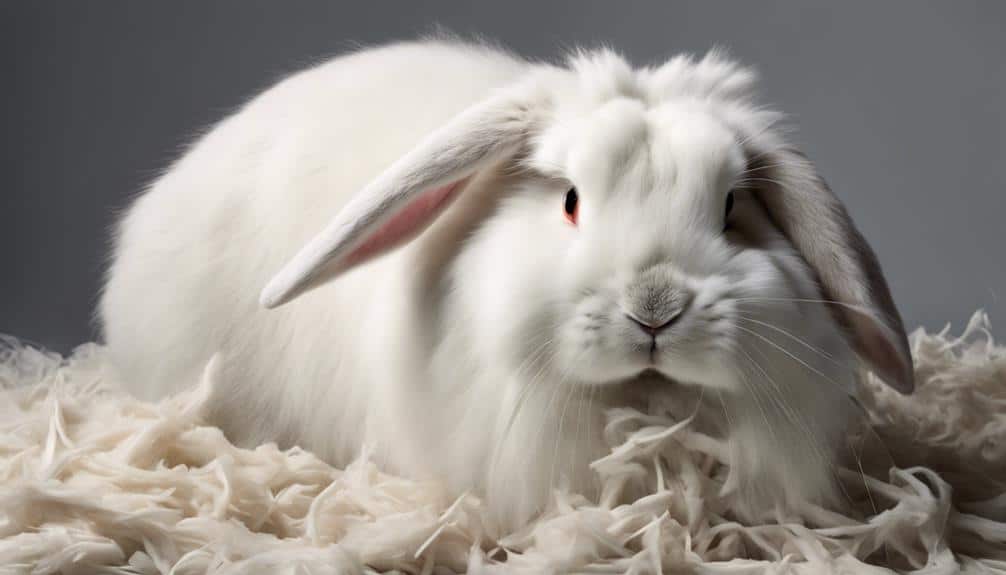
When bunnies molt, they do so to shed old fur and make way for new growth, which helps them regulate body temperature by adjusting their fur density. Factors like stress, seasonal changes, and diet can trigger molting in bunnies.
Understanding the reasons behind bunny molting involves exploring the molting process, seasonal shedding patterns, and the various factors that can affect how and when bunnies molt.
Molting Process Explanation
During the molting process in rabbits, various factors such as genetics, seasonal changes, diet, stress, and grooming habits play a significant role in influencing how and why bunnies shed their coat. This shedding phase is vital for your pet's well-being.
Here are key points to take into account:
- Genetics: Determine the natural shedding patterns inherited by your bunny.
- Diet: Make sure your rabbit's nutrition supports healthy fur growth.
- Grooming: Regularly brush your bunny to assist in shedding and prevent fur matting.
Understanding these factors can help you support your rabbit through the molting process effectively.
Seasonal Shedding Patterns
To understand the reasons behind bunny molting, consider the seasonal shedding patterns that rabbits exhibit, particularly in response to changing temperatures. Rabbits molt to adjust to changing temperatures and regulate body temperature.
Seasonal shedding patterns in bunnies typically occur in the spring and fall, with molting helping them shed excess fur. During molting, rabbits may display increased shedding, fur tufts, and changes in coat texture.
Proper grooming and a balanced diet are essential in managing bunny molting to prevent health issues and support new fur growth. By recognizing these seasonal shedding patterns and providing adequate care, you can help your bunny maintain a healthy coat and overall well-being.
Factors Affecting Molting
Molting in bunnies is influenced by various factors such as genetics, seasonal changes, diet, stress, and grooming habits. Genetics play an important role in determining when and how intensely rabbits molt. Seasonal variations, particularly temperature fluctuations, can trigger molting as bunnies adjust their fur thickness.
Providing a balanced diet rich in essential nutrients is key to supporting healthy molting in rabbits. Stressful situations or environmental changes can also impact the molting process, causing irregular shedding patterns. Ensuring your bunny's grooming habits are maintained can aid in a smoother molting change.
Impact of Molting on Rabbits
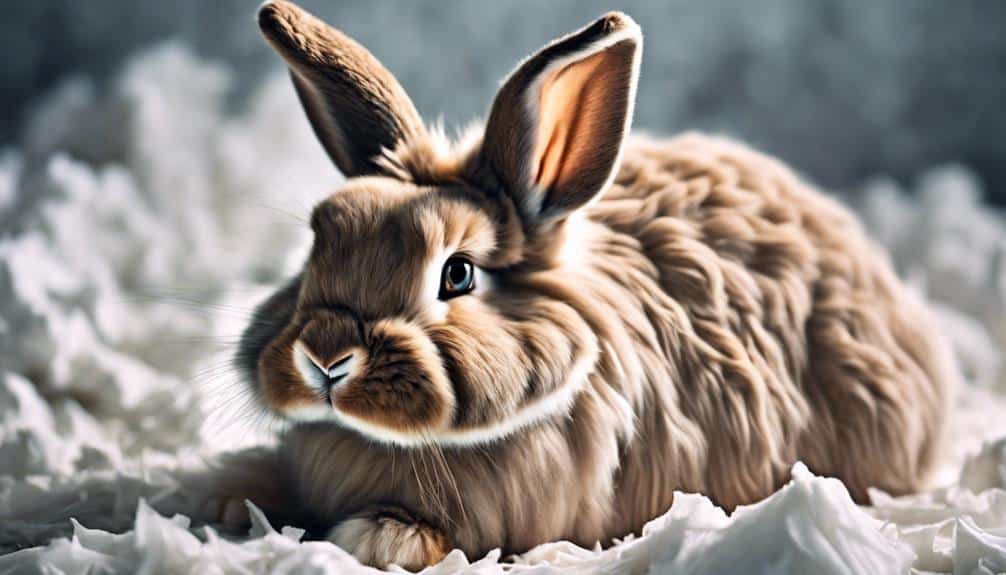
During molting, rabbits shed their old fur to maintain fur health and regulate body temperature.
Molting frequency can vary based on genetics, diet, and grooming practices.
Understanding the impact of molting on rabbits can help you guarantee their well-being and address any health concerns that may arise.
Molting Frequency
Rabbits undergo molting twice a year, impacting their shedding frequency and coat appearance. This natural process is essential for your furry friends' well-being. Understanding molting frequency in adult rabbits can help you provide best care:
- Molting can lead to changes in coat color and hair loss, affecting your rabbit's appearance.
- Stress and diet play a significant role in triggering molting, influencing shedding patterns.
- The shedding process typically starts at the nose and progresses towards the tail, indicating a natural shedding cycle.
Fur Health
Understanding the impact of molting on rabbits' fur health is important for maintaining their overall well-being and appearance. Rabbits shedding their fur during the molting process helps prevent issues like fur matting, skin problems, and assists in regulating their body temperature.
Grooming your rabbit regularly while they molt is essential to remove loose fur and avoid fur ingestion. Ensuring your rabbit's diet is high in fiber supports their digestive health during this period.
It's important to monitor your rabbit for any signs of fur blockages or skin problems that may arise during the molting process. By paying attention to these factors, you can help your rabbit maintain excellent fur health and overall wellness.
Managing Rabbit Shedding
When managing rabbit shedding, regular brushing during shedding seasons can help rabbits lose their coat faster and effectively manage fur in the home. Shedding is a natural process for rabbits to adjust to different seasons, with thick fur for winter and a thinner coat for summer. It typically lasts 2-6 weeks, starting in March-April for the winter coat and October-November for the summer coat. Shedding usually begins at the head and progresses down the backside, aiding in the regulation of body temperature.
- Brushing: Gently brushing your rabbit helps remove loose fur and prevents matting, promoting a healthier coat.
- Consistency: Regular grooming sessions create a bonding opportunity and maintain a clean environment for both you and your rabbit.
- Comfort: By assisting in the shedding process, you help your rabbit feel more comfortable and prevent potential health issues related to excessive fur.
Tips for Helping Molting Bunnies
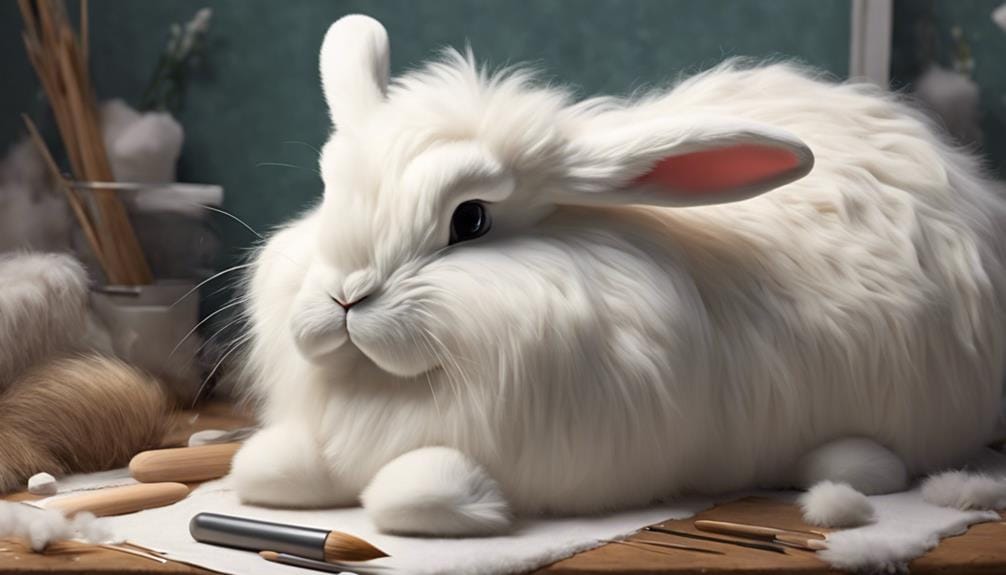
During molting, training your bunny to enjoy brushing sessions is important for effective fur management. Brush your rabbit daily, focusing on removing loose fur down to the skin.
Use wide-toothed combs and flea combs to help remove the undercoat and prevent matting. Since domestic rabbits are kept for their fur, maintaining the fur in good condition is vital. Rabbits may lose fur in patches during molting, so regular grooming is key.
Remember, rabbits can't vomit, so monitoring their droppings for any signs of gastrointestinal stasis during this time is crucial. If you encounter stubborn mats or skin issues related to molting, seek help from a vet promptly.
Recognizing Molting Patterns in Rabbits
As your bunny goes through the molting process, observe the shedding patterns to gain insights into its coat health and grooming requirements. Seasonal molts are a natural part of your rabbit's life, and understanding the shedding patterns can help you care for your furry friend better. Here are some key points to take into account:
- Molting Duration: Molting can last between 2 to 6 weeks or even longer, varying from rabbit to rabbit. Patience is key during this period as your bunny gets rid of its old coat and grows a new one.
- Patchy Shedding: Some rabbits may experience patchy shedding where fur falls out unevenly. This is normal and should resolve as the molt progresses.
- Temperature Regulation: Seasonal molts, especially at the end of winter and summer, help rabbits regulate their body temperature by adjusting the thickness of their coat.
Dealing With Rabbit Hair Loss
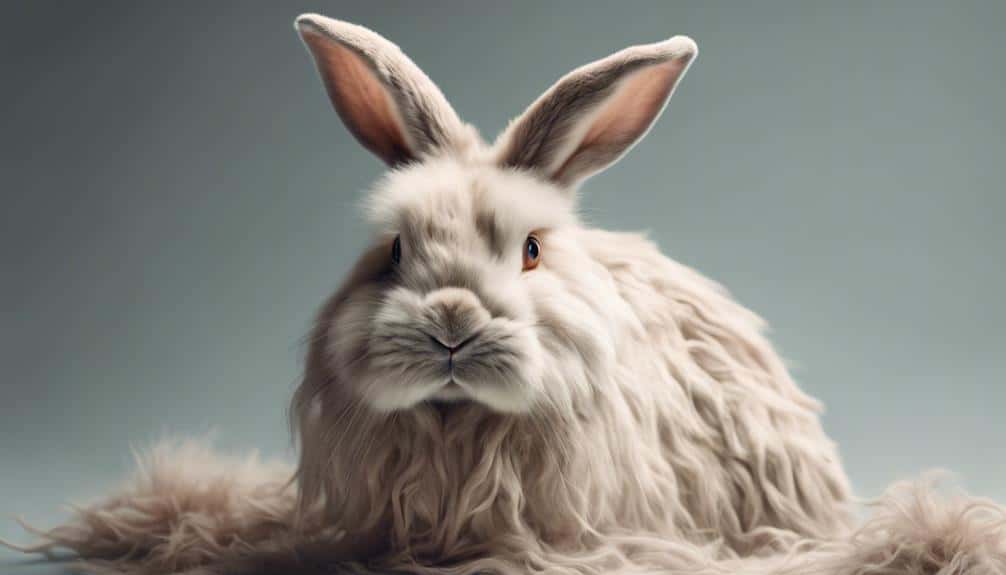
To effectively address rabbit hair loss during molting, proactive grooming and vigilant monitoring are essential to guarantee your bunny's health and well-being. During molting, rabbits shed their old coat to make way for a new one, which is a natural process.
However, hair loss can pose risks, such as fur blockages in the digestive system if the loose hair is ingested. Regular brushing helps manage shedding and reduces the chances of hairballs forming. Keep an eye out for signs of excessive hair ingestion, such as reduced appetite or changes in fecal output.
Ensuring your rabbit has a balanced diet rich in fiber and providing ample hydration can also aid in preventing digestive issues during molting. If you notice severe hair loss or skin problems, seeking veterinary advice is vital for proper grooming and care.
Rabbit Molting Care Essentials
When caring for a rabbit experiencing molting, it's important to prioritize regular grooming to prevent potential fur blockages and other associated health issues. Proper care during this time can make a significant difference in your rabbit's well-being.
Here are some essential tips to help you care for your molting rabbit effectively:
- Regular Grooming: Gently brush your rabbit's fur to remove loose hair and prevent matting, which can lead to fur blockages.
- Balanced Diet: Make sure your rabbit's diet is rich in fiber to aid digestion and help pass ingested fur smoothly through the digestive tract.
- Monitoring Digestive Issues: Keep a close eye on your rabbit's droppings for any signs of gastrointestinal problems, as molting can sometimes lead to digestive issues if not managed carefully.
Do Bunnies Stop Molting When They Are Breastfeeding?
Yes, bunnies do stop molting when they are breastfeeding. This is one of the interesting bunnies breastfeeding facts. The hormonal changes during lactation can slow down or stop the molting process in bunnies. It’s a natural adaptation to ensure that the mother rabbit can focus on caring for her young.
Frequently Asked Questions
How Do I Know if My Rabbit Is Molting?
To know if your rabbit is molting, observe increased shedding, fur tufts, and changes in texture. Monitor shedding patterns and adjust grooming routines accordingly. Brush gently to remove loose fur. Consider seasonal changes, dietary needs, and health concerns.
What Does Molting Look Like on Rabbits?
During the molting process, rabbits display shedding patterns with fur loss starting at the head. To maintain healthy hair care, incorporate grooming routines, such as brushing techniques. Seasonal changes can affect fur texture and color.
Why Is My Indoor Rabbit Shedding so Much?
Your indoor rabbit may shed excessively due to diet changes, stress factors, grooming routine, seasonal shedding, allergy concerns, or shedding patterns. Consult a vet for advice on managing shedding through proper care routines.
Do Rabbits Lose Their Fur in the Summer?
During summer, rabbits molt to adapt to warmer weather, shedding their winter coat. Grooming techniques, diet influence, and proper care aid in managing shedding patterns and maintaining fur health. Brush regularly for coat care.
Conclusion
So, next time you see your bunny shedding fur, remember that they're just going through a natural process to keep themselves healthy and comfortable.
Just like a snake shedding its skin, your bunny is renewing its coat to stay fresh and clean.
Embrace the molting season as a sign of growth and renewal for your furry friend.
Happy grooming!


